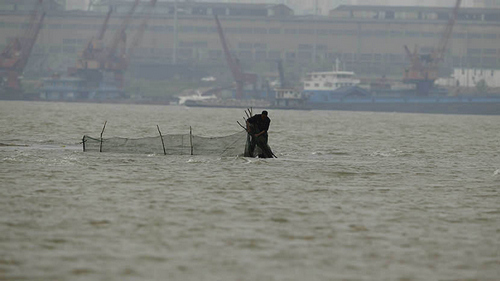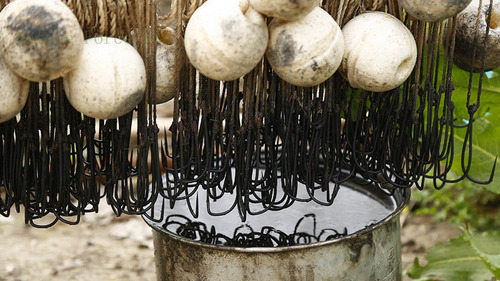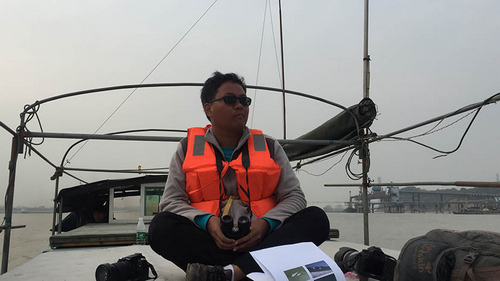
Newsroom
Hope Springs Eternal on Yangtze Dolphin Quest
From his perch on a fishing boat, Song Qi spots a circle of white bubbles on the surface of the water.
Jumping to his feet, he hits his head against the bamboo poles fishermen use when taking shelter from rain.
"Look! A white spot!” he shouts, pointing frantically to an area about 300 meters ahead.
Song is among a group of nine volunteers who set sail late last month on the Yangtze, China’s longest river, on a five-day expedition in search of baiji.
One of only seven species of freshwater dolphin in the world, the baiji dolphin — popularly known as the “goddess of the Yangtze” — is the largest mammal living in the river.
Or at least it used to be. Now, apart from the occasional uncorroborated sightings by fishermen who ply these waters, there is good reason to believe the white-skinned, long-beaked dolphin is now extinct.
A decade ago, a survey conducted by researchers from six countries failed to find a single baiji, forcing the team to declare the species “functionally extinct.”
This means that while a very small number of baiji dolphins may actually still exist, the number is not sufficient to save the species from extinction, according to the survey's head researcher, Wang Ding, an expert on freshwater dolphins at the Institute of Hydrobiology at the Chinese Academy of Sciences (CAS) in Wuhan, Hubei province. The last known baiji, known affectionately as Qiqi, died in captivity in 2002 at the institute.
"Deep in my heart, I can’t believe they no longer exist,” Song, the dolphin spotter, told Sixth Tone.
This conviction has pushed him and others to comb the river in search of signs of baiji dolphin life. Buoyed by the proceeds from online crowdfunding, the volunteers on this trip include conservationists from non-government organizations as well as employees from Chinese state-owned companies. For many of these men and women, who are mainly in their 20s and 30s, it is their first time to meet one another. Their passion for baiji helps forge strong bonds as they set off in two small fishing boats rented from local fishermen along a route mapped out following detailed discussions with freshwater dolphin experts.
The population of baiji has dropped dramatically since the 1950s, mainly due to increased human activity along the Yangtze. Since the 1980s, China has pushed to develop the river into a major shipping route, building a series of locks and dams, including the Three Gorges Dam, to enable larger cargo-carrying ships to sail from China’s heartland down to the sea near Shanghai. This, together with overfishing and the discharge of wastewater, has resulted in the loss of biodiversity in the river, experts say.
A 2013 joint study by the World Wide Fund for Nature and China’s Ministry of Agriculture shows that fishery resources in the upper reaches of the Yangtze are on the verge of collapse, while data from CAS show that a third of the river-dwelling species endemic to the area are at, or near, the point of extinction.
 |
| A fisherman uses a maze fishing net despite a fishing ban in place at the Yangtze River, March 21, 2016. Maze fishing nets are named after their labyrinthine quality — once a fish is caught, it never finds its way out. Usage of the net is illegal. Hui Ying for Sixth Tone |
In 1996, the International Union for Conservation of Nature raised the status of baiji on its red list of threatened species from "endangered” to “critically endangered.” By the end of the 1990s, there were only about 20 left in the Yangtze, according to CAS estimates.
Another species of freshwater dolphin, the Yangtze finless porpoise, currently lives in the river and its connected lakes. It is nicknamed the “angel of smiles,” because its short, upward-tilted beak resembles a smiling human. Just like the baiji, the Yangtze finless porpoise is also listed as critically endangered — and has been since 2013. According to a survey by CAS in 2012, the latest available, there were 1,040 Yangtze finless porpoises left. By contrast, scientists estimated that were around 2,700 in the 1990s.
 |
|
Types of illegal hooks, which cause great harm to fish, beside the Yangtze River, March 20, 2016. Hui Ying for Sixth Tone |
Wang, the freshwater dolphin expert at CAS, said that if such policies are implemented properly then that could spell hope — if not for baiji then at least for the Yangtze’s other endangered species.
 |
| Volunteer, Ji Yingying, on the lookout for baiji dolphins in the Yangtze River, March 21, 2016. Shi Yi/Sixth Tone |
Back on the fishing boat on the Yangtze, Song and his fellow dolphin spotters talk animatedly about the white bubbles, speculating that they were formed by baiji. But the lack of any hard evidence means they can’t say for sure that theirs is a true "sighting.”
Still, the group of volunteers won't let that dampen their spirits. “It’s too early to give up,” says Song. “If we can manage to spot them, there is still hope.” (Sixth Tone)
In March, the State Council – China’s cabinet – issued its latest five-year plan of social and economic policy goals, which, among others, pledged to improve the quality of water in the river, to pay greater attention to balancing development with conservation on its riverside, and to take a number of steps aimed at restoring the river’s ecology. In January, during a visit to Chongqing, a city that straddles the Yangtze, Chinese President Xi Jinping emphasized the importance of “green development” along the Yangtze, suggesting a greater willingness by the central government to weigh ecological concerns over economic development.